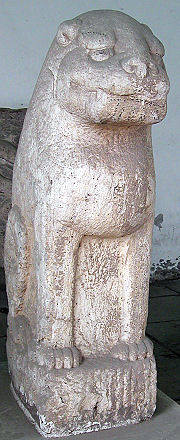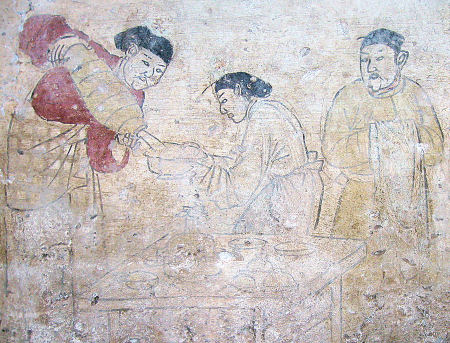
Jin dynasty mural
Zhongdu was established as Jin's central capital in year 1153 by Jin ruler Hailing Wang. The city was designed by Lu Yanlun, also chief planner of Jin's northern capital Shanjing. 800,000 men and 400,000 troops took part in the construction ("Chinese Imperial City Planning", N.S. Steinhardt, 1990).
Zhongdu nearly formed a square and totally contained its predecessor capital on this location, Nanjing (or Yanjing) of the Liao dynasty, inside its outer walls. The outer wall perimeter was about 17 kilometers and had three gates on all sides except an odd and rather unusual fourth gate in the east of the northern wall.
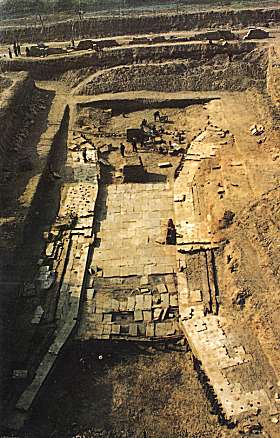
Zhongdu water gate being excavated.
The people in the upper half
give a good impression of size
The gates were connected with their respective counterpart east-west or north-south by a wide main boulevard except for the central boulevards, which were connecting directly into the Imperial City in the center of Zhongdu.
The inner wall around the Imperial City measured some 5-6 kilometers and fully enclosed the Palace City. The Imperial City wall had two gates on each side. The two northern gates, Tongxuanmen and Chongzhimen, formed part of the outer wall and the southwestern gate, Xuanyangmen, was shared with the Palace City.
No, not the building complex in Washington DC, U.S.A., which became President Nixon's downfall. Water gates were a natural part of all Chinese walled cities as this is where water flowed in and out of the city.
At Zhongdu, these watergates were massive constructions. They were not merely used for channeling sewage and rain water, but since Zhongdu was built with a river flowing right through, then the gates also served as in- and outlets of the entire river.
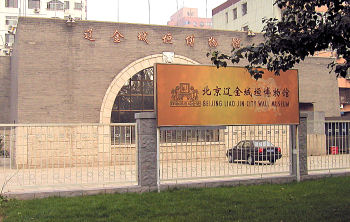
Beijing Liao Jin City Wall Museum
When further considering that the skill in controlling seasonal floodings was less than desirable, then the gates also had to be large enough to handle huge surges of flood water. The image above shows the southern water gate of Zhongdu city in the final stage of excavation.
The water flowed from bottom (north) to top on the image, transpiercing the city wall, which ran right-left in the center. This water gate was the main exit point for the city's river based water flow. Liangshui River, which in 1153 doubled up as part of Zhongdu's protecting city moat, still flows today just outside the top of the picture.
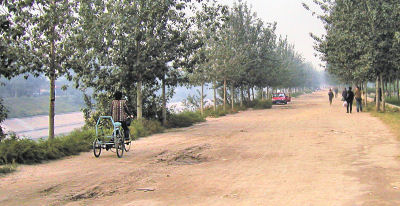
Northern bank of Liangshui River (left)
The museum is located to the right of the red taxi
For security reasons these gates were protected with a kind of portcullis to prevent intruders from entering the city. The failure of the Qing dynasty military to closely guard Beijing's water gates allowed easy and unchallenged access for foreign troops entering Beijing in year 1900.
The water gate is the only other main extant Zhongdu relic and can be seen today in the basement of the Beijing Liao Jin City Wall Museum (picture above). Where is it? Some 500 meters straight south of the western most exit from the 2nd Ring Road southern section. It is poorly marked, so if you get lost then just follow the northern bank of Liangshui River.

If you wonder why you don't stumble into all these historic sites around town then bear in mind that Beijing keeps burying itself with top soil. Sand and soil have in the last 900 years or so accumulated to such an extent that this water gate now is buried some 5-6 meters beneath today's surface. It had obviously long been forgotten and was only uncovered by coincidence due to an excavation for the construction of an apartment complex.
Before wrapping up the city wall of Zhongdu it would only be fair to highlight that it was the Jin who constructed the still famous and still existing marvelous Lugou bridge - better known to Westerners as the "Marco Polo Bridge". It was located some 10 kilometers southwest of old Zhongdu and was an important crossing from west into the capital.
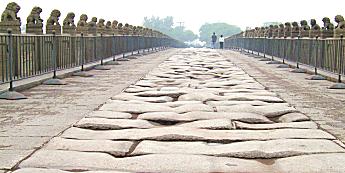
The "Marco Polo Bridge"
Elsewhere on these pages you can find an entire feature on this bridge and all its lions, but for now let Marco Polo have the last word:
"(...) Upon leaving the capital [Kublai Khan's Dadu] and traveling 10 miles you come to a river named Pulisangan [today's Yongding River]. (...) Over this river there is a very handsome bridge of stone, perhaps unequalled by any other in the world. Its length is 300 paces and its width 8 paces; so that ten mounted men can, without inconvenience, ride abreast. It has twenty-four arches, supported by twenty-five piers erected in the water, all of serpentine stone, and built with great skill.
On each side, and from extremity to the other, there is a handsome parapet, formed of marble slabs and pillars arranged in masterly style. (...) There is a handsome column or pillar, with its lion [on top], at a pace and a half from the former; and all the spaces between one pillar and another (...) are filled up with slabs of marble, curiously sculptured, and mortised into the next adjoining pillars, forming altogether a beautiful spectacle."
